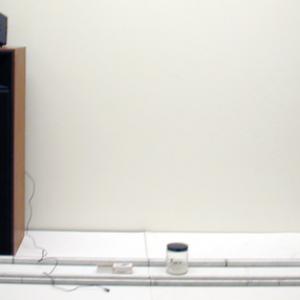College of Liberal Arts & Sciences
3D40.20 - Singing Rods
Make sure that there is a fresh battery in the microphone. Plug the microphone into the amplifier and the amplifier into the oscilloscope. Support one of the rods vertically with a tube clamp. Put the foam rubber shield gently against the side of the rod. Insert the microphone into the shield but not so that it touches the rod. Most of the rods have places marked with magic marker or tape on them. When held at these places (Nodes) the rod will vibrate at a resonant frequency. When held somewhere else the frequencies will be damped. When the tube clamp is holding the rod at one of the node points and the end of the rod is struck the sinusoidal waveform will appear on the oscilloscope.
If you don't want to use the amplifier and microphone you can place a Styrofoam cup so that it touches the end of the rod after it has been excited.
NOTE: The rod must be struck on the ends NOT on the side or the results will be most disappointing.
The best way to make this demo work is to put rosin on your fingers and stroke the rod at about the 1/4 length position. A very irritating and loud whine should result. In place of rosin you can also rub your fingers with.
- Michael Hirth, Sebastian Gröber, Jochen Kuhn, and Andreas Müller, "Harmonic Resonances in Metal Rods – Easy Experimentation with a Smartphone and Tablet PC", TPT, Vol. 54, #3, Mar. 2016, p. 163.
- B. Lasby, J. M. O'Meara, and M. Williams, "The Singing Rod (in the Modern Age), TPT, Vol. 52, #2, Feb. 2014, p. 86.
- Charles A. Sawicki, "Induced Current Measurement of Rod Vibrations", TPT, Vol. 41, #1, Jan 2003, p. 42.
- Ronald D. Wong, "Vibrating Rods and More", TPT, Vol. 35, #7, Oct. 1997, p. 387.
- David R. Lapp, "Harmonics in an Aluminum Rod. 'A Golden Oldie'", TPT, Vol. 35, #5, May 1997, p. 314.
- Ernie McFarland and Tom Kehn, "The Fantastic Physics Fun Show", TPT, Vol. 34, #8, Nov. 1996, p. 512.
- John W. Jewett Jr., "Giving New Meaning to 'Resonance in Pipes'", TPT, Vol. 31, #4, Apr. 1993, p. 253.
- James E. Kettler, "Listening for Young's Modulus", TPT, Vol. 29, #8, Nov. 1991, p. 538.
- Earl R. Pinkston, "The Use of Demonstrations in Teaching Introductory Physics", TPT, Vol. 19, #6, Sept. 1981, p. 387.
- Michael J. Moloney, "Measuring and Calculating Bar Flexural Vibration Frequencies", AJP, Vol. 73, #5, May 2005, p. 439.
- Alejandro Morales, Luis Gutiérrez, and Jorge Flores, "Improved Eddy Current Driver-Detector for Elastic Vibrations", AJP, Vol. 69, #4, Apr. 2001, p. 517.
- Francesca M. F. Mascarenhas, C. M. Spillmann, John F. Lindner, and D. T. Jacobs, "Hearing The Shape Of A Rod By The Sound Of Its Collision", AJP, Vol. 66, #8, Aug. 1998, p. 692.
- Harold A. Daw and Robert J. Liefeld, "Driven Singing Aluminum Rods", AJP, Vol. 66, #7, July 1998, p. 639.
- R. C. Nicklin, "Measuring the Velocity of Sound in a Metal Rod", AJP, Vol. 41, #5, May 1973, p. 734.
- Nobuo Naba, "Observation of Longitudinal Vibration of Metal Rods", AJP, Vol. 40, #9, Sept. 1972, p. 1339.
- Richard Berg, "Singing Aluminum Rod Demonstration", PIRA Newsletter, Vol. 10, #1, Sept. 1995, p. 5.
- "W-365. Velocity Sound - Aluminum Rod", DICK and RAE Physics Demo Notebook, 1993.
- "W-205. Singing Rod", DICK and RAE Physics Demo Notebook, 1993.
- "W-135. Coupled Oscillations in Rod", DICK and RAE Physics Demo Notebook.
- Tik Liem, "The Multiple Tuning Pipe", Investigation to Science Inquiry, p. 307.
- Tik Liem, "The Resonating Bar", Investigation to Science Inquiry, p. 306.
- George M. Hopkins, "Reeds", Experimental Science, p. 121.
- R. W. Pohl, "Vibrations", Physical Principles of Mechanics and Acoustics, p. 242.
- Borislaw Bilash II and David Maiullo, "Singing Rods", A Demo a Day: A Year of Physics Demonstrations, p. 219.
- Robert Ehrlich, "K.2. Shaking a Rod Vibrating in its Longitudinal Mode", Turning the World Inside Out and 174 Other Simple Physics Demonstrations, p. 144.
- Robert Ehrlich, "J.11. Longitudinal Waves in a Rod", Turning the World Inside Out and 174 Other Simple Physics Demonstrations, p. 137 - 138.
- Joseph Frick, "#147 - Longitudinal Vibrations", Physical Technics: Or, Practical Instructions for Making Experiments in Physics and the Construction of Physical Apparatus with the Most Limited Means", p. 174.
Disclaimer: These demonstrations are provided only for illustrative use by persons affiliated with The University of Iowa and only under the direction of a trained instructor or physicist. The University of Iowa is not responsible for demonstrations performed by those using their own equipment or who choose to use this reference material for their own purpose. The demonstrations included here are within the public domain and can be found in materials contained in libraries, bookstores, and through electronic sources. Performing all or any portion of any of these demonstrations, with or without revisions not depicted here entails inherent risks. These risks include, without limitation, bodily injury (and possibly death), including risks to health that may be temporary or permanent and that may exacerbate a pre-existing medical condition; and property loss or damage. Anyone performing any part of these demonstrations, even with revisions, knowingly and voluntarily assumes all risks associated with them.

